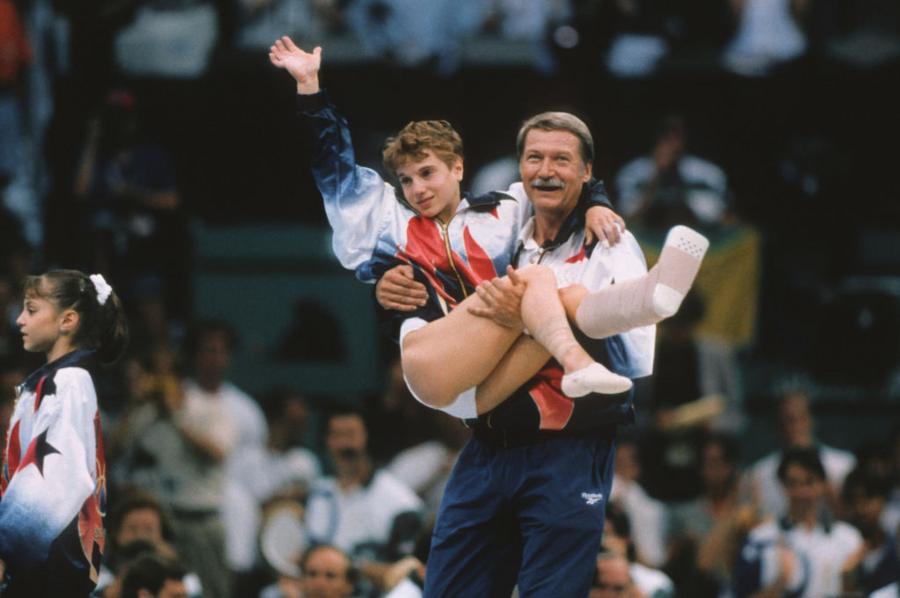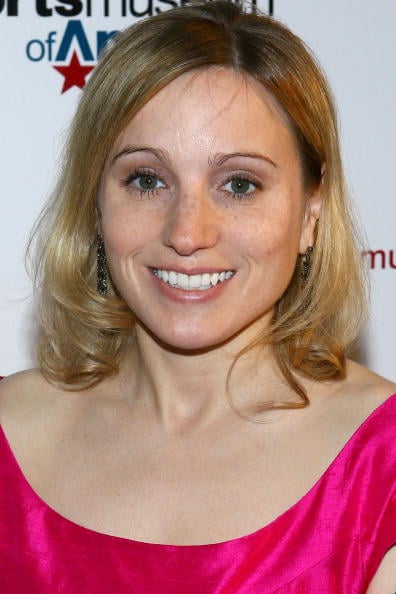What Is Kerri Strug's Net Worth?
Kerri Strug is a retired American gymnast who has a net worth of $2 million. Kerri Strug was a member of the Magnificent Seven, the victorious women's gymnastics team that represented the United States at the 1996 Summer Olympics. Strug participated in the vault event, and it was her performance that clinched the gold for the American team despite having injured her ankle just before the event.
Early Life
Kerri Strug was born on November 19, 1977, in Tucson, Arizona. She is the daughter of Melanie Barron and Dr. Burt Strug. Kerri's father worked as a cardiovascular surgeon, and she was raised in a Jewish family. She began training in gymnastics at the age of three and competing in the sport at the age of eight. Her sister Lisa also competed in gymnastics. Strug attended different schools throughout her youth due to her intensive training. In 1995, well into her professional career, she graduated from Green Fields Country Day School in Tucson.
Career
In January 1991, Strug began training with coach Bela Karolyi. That year, she joined the United States National Team. In 1992, as the youngest member of the entire U.S. team at the age of 14, she won a bronze medal at the Barcelona Olympics. Throughout the Team Compulsories and Optionals, Kerri and Kim Zmeskal competed for the final US available spot to compete in the all-around event. She eventually was beaten in points by Zmeskal and did not get to compete on the 1992 all-around team.
After the 1992 games, Strug moved to Edmond, Oklahoma, to train under Steve Nunno at the Dynamo Gymnastics Club. While there, she suffered a serious injury to her stomach and had to recover over a period of months. At the 1993 Nationals, she placed third in the all-around, second on the uneven bars, and third in the floor exercise event. She did not medal in the vault event. After this competition, Kerri returned to her home in Tucson, where she trained with Arthur Akopian and Jim Gault.
The next year, in 1994, she suffered another injury while training on the uneven bars. She lost control during a transition and flew off the high bar backward, landing in a twisted position on her side. She was carried out of the gym on a stretcher and taken to the hospital. She sustained a badly pulled back muscle, which required extensive rehabilitation. However, she was able to recover in time for the 1994 World Championships. In 1995, she began training in Colorado Springs with Tom and Lori Forster. At the 1995 Nationals, she placed fifth in the all-around and third on the uneven bars. At the World Championships that year, she was a member of the bronze medal-winning U.S. team and placed seventh in the all-around.

(Photo by David Madison/Getty Images)
In preparation for the 1996 Olympics, Strug moved back to Houston to train again with Karolyi. She did well in other events leading up to the Olympics, placing first on floor exercises and balance beam at the American Cup and second on vault and floor at the 1996 U.S. Nationals. She made the cut for the U.S. 1996 Olympics women's team, which came to be known as the Magnificent Seven.
After strong performances in the individual events, Strug qualified for the event finals in the team competition. Going into the team event, the Russians held a narrow lead. The points were so close among the teams that the event came down to the final rotation on the final day of team competition. After a challenging performance by the rest of the U.S. team in the vault event, Strug was the last to vault for the United States. During her first attempt, she under-rotated, causing her to fall and injure her ankle. In order to ensure the U.S. team the chance to beat Russia, Kerri had to vault again and earn a much higher score than her first attempt. After conferring with her coach, she agreed to vault again, landing on both feet despite her injury. She performed well enough to secure the victory for the U.S. team.
Strug had to be carried to the medal podium as she was unable to walk, and the rest of the team refused to attend the ceremony without her. Afterward, she was taken to the hospital to be treated for a serious sprain and tendon damage. She was unable to compete in the remaining events, but she became a national hero for her final vault. She would go on to appear on the cover of "Sports Illustrated," a Wheaties cereal box, and in several ESPN campaigns.

Scott Wintrow/Getty Images
Post Olympics
After the 1996 Olympics, Strug participated in the Ice Capades and Disney's World on Ice. She then announced her retirement and enrolled at UCLA to begin her university studies. There, she was a member of the Kappa Alpha Theta women's fraternity. Because she had been a professional gymnast, she was unable to compete in NCAA gymnastics events on behalf of UCLA. Instead, she worked for a time as the gymnastics team manager. She later transferred to Stanford University, where she earned a master's degree in social psychology.
After graduating, Strug worked as an elementary school teacher in San Jose, California. She then moved to Washington, D.C. in 2003. She worked as a staff assistant with the White House Office of Presidential Student Correspondence. Kerri then moved to a job as the General Counsel in the Treasury Department. In March 2005, she joined the Justice Department's Office of Juvenile Justice and Delinquency Prevention staff as a presidential appointee.
After her retirement, Strug participated in the 2004 Summer Olympics in Athens as a correspondent for Yahoo! in artistic gymnastics. Given the impact she made on American culture, Kerri has also been mentioned several times in popular shows like "Sabrina: The Teenage Witch," "Beverly Hills, 90210," "Bojack Horseman," "King of the Hill," "Community," "Murphy Brown," "Roseann," "Saved by the Bell," and "Mythic Quest."
Personal Life
In 2010, Strug married attorney Robert Fischer at the Skyline Country Club in Tucson, Arizona. In 2012, she gave birth to the couple's first child, a son. In 2014, the couple welcomed a second child, a daughter. Strug enjoys running and has competed in marathons in cities around the United States.
/2016/08/kerri-strug-1.jpg)
/2022/07/suni-lee.jpg)
/2016/08/Laurie-Hernandez.jpg)
/2013/03/mck.jpg)
/2012/06/Nastia-Liukin.jpg)
/2016/07/dm.jpg)
/2020/07/mlp.jpg)
/2010/01/Deryck-Whibley.jpg)
/2020/07/jl.jpg)
/2010/01/GettyImages-183679600.jpg)
/2022/10/Anne-Murray.jpg)
/2014/09/Kim-Delaney.jpg)
/2009/11/Tim-Duncan.jpg)
/2023/01/lance-armstrong.jpg)
/2021/04/Sara-Gilbert.jpg)
/2025/03/Kelli-Ferrell.jpg)
/2010/05/Jaleel-White.jpg)
/2016/08/kerri-strug-1.jpg)
/2016/07/dm.jpg)
/2016/08/Laurie-Hernandez.jpg)
/2012/08/jordyn.jpg)
/2012/08/Gabby-Douglas-1.jpg)
/2012/08/Dominique-Dawes-e1596677303563.jpg)
/2013/03/mck.jpg)
/2022/01/mary-lou.jpg)